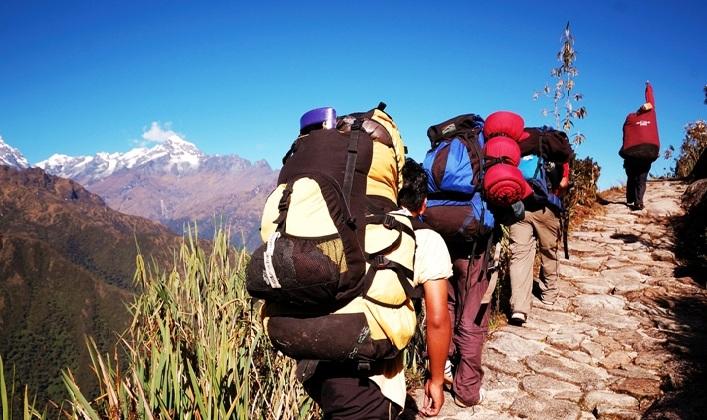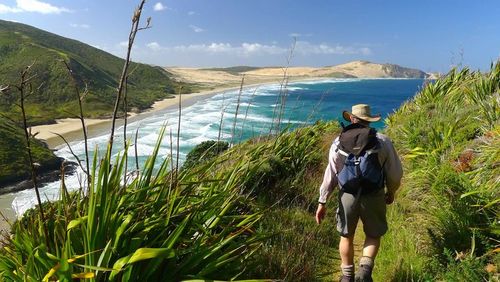There is a nice, isolated waterhole nearby, the sun is pounding down, and you can hear a waterfall roaring. It’s time to go on a summer hike to take advantage of the pleasant weather.
But let’s go over the fundamentals first. What to wear hiking in summer? If the sun is out, you probably will be heated and perspiring before you even begin trekking. You need be equipped with a few hot-weather hiking necessities, lots of water, and some safety advice in order to stay comfortable and safe.
Table of Contents
Summer Hiking Tips For Beginners
Summertime hiking isn’t always enjoyable. You should think about a few genuine risks, but there are also precautions you can take to improve the quality of your outdoor experiences. Here are four summer hiking tips for newbies before you head out on the trail.
Fabric Is Important, But Not As Much As In The Winter
If you read my post on what to wear while winter hiking, you already know that it’s crucial to wear wicking clothing close to your body to avoid hypothermia. In the winter, cotton close to your skin is strongly advised against as it traps moisture. Although hypothermia is extremely unlikely to strike in the summer (unless you’re hiking at a high altitude), there are still other reasons to give wearing cotton next to your skin a second thought.
In the beginning, wearing cotton while hiking in the summer can make you uncomfortable or chafe. This might not be a big deal on shorter hikes, but it can get pretty uncomfortable on longer hikes. Second, bring a change of dry clothes if you intend to hike in the evening or at an altitude where the temperature may drop so that you don’t trap moisture next to your skin in the colder temperatures.
Pro tip: Cotton retains moisture for longer periods of time and can absorb up to 7% of its weight in water or sweat. Less than 0 will be absorbed by synthetic and wicking materials.5% of their weight and dry quickly.
In any climate, I advise wearing breathable, wicking materials close to your skin whenever possible. Wool or synthetic materials, especially when it comes to your feet, are meant.
Sun Protection For The Entire Body
Sun protection isn’t just for your face, arms, and legs! Don’t forget to use sunscreen on the back of your neck, scalp, and ears. These areas should be covered in sunscreen. To further help protect one or more of these parts of your body, think about bringing a hat with you.
Spray sunscreens may be simpler to use in these difficult-to-reach places if you hike alone, like I do. Make sure to reapply sunscreen every few hours, ideally before you start to experience the symptoms of sunburn.
Layer Up
Hear me out before you decide to layer up while hiking in warm weather. Prolonged exposure to the sun can be extremely dangerous, even with the best sunscreen. Having extra clothing could also literally save your life if you become lost, hurt, or stuck in a dangerous environment.
Think about including a long-sleeved top that is lightweight, loose-fitting, and breathable in your daypack. Bring a pair of lightweight leggings or ankle-length pants if zip-off pants aren’t your thing (I can’t stand them).
Last summer, when I went hiking in the Badlands, I was so grateful to have a long-sleeved shirt. My sunscreen simply wasn’t enough, and there was no shade, somewhere around mile 8 in the midday sun. My lightweight long sleeve top had a small collar that helped shield not only my arms and shoulders but also my neck.
During the summer, I wore a thin blue long sleeve top with black shorts to watch the sun set in Badlands National Park.
For hiking in the summer in Badlands National Park, my go-to lightweight, breathable long sleeve shirt.
Maintaining Hydration Should Be A Priority
It’s not enough to simply drink water the entire time you’re hiking to stay hydrated. Additionally, it doesn’t entail drinking little amounts of water to avoid using the restroom on the trail. In addition to losing water when you perspire, your body also loses sodium and other minerals. Low blood sodium levels, or hyponatremia, can cause seizures, stumbling, and confusion when consumed in excess or insufficiently with no replacement of sodium.
It’s critical to replenish the sodium your body loses through sweat when hiking in hot weather or over long distances. Bringing salty snacks like trail mix, salty nuts, or jerky is a simple way to accomplish this. As an alternative, bring electrolyte packets like Propel or Gatorade to mix with water. I use this keto-friendly electrolyte powder, which is available in single-serving pouches that are great for hiking.
Important Clothing For What To Wear Hiking In Summer
A Breathable Shirt
A Long-sleeved top
On days with a lot of UV exposure, it’s a good idea to wear a breathable long-sleeved top to protect your skin. There are several options that will also keep you cool.
The Flinders Merino Top is a good starting point. It has flat seams and ventilation paneling because it is made for hiking. Due to merino’s ability to naturally regulate body temperature, this wool will help you stay cool.
The UPF50+-rated, lightweight Tapah Women’s Hiking Shirt is a great option if you’d prefer something a little lighter. It also has excellent moisture management. Additionally, it dries quickly, prolonging the time you feel fresh.
A T-shirt
To keep your shoulders shielded from the sun and from any potential rubbing or chafing from your backpack, we’d at the very least advise wearing a shirt. The Barros Men’s Hiking Shirt or the Vipan Women’s Hiking Shirt is both suitable choices. Your neck’s back will benefit from the sun protection provided by the collapsible collar visor.

Shorts Or Pants Designed For Hiking
Shorts
There are many options available, and for the majority of people, these are the preferred summer hikes.
The women’s Maraba hiking shorts are a straightforward pair of lightweight, quick-drying shorts that make for a simple, comfortable hike, and the men’s Trailhead hiking shorts are both moisture-wicking and quick to dry.
Choose shorts with a mesh inner, like the Drimotion shorts, if you want to incorporate some running into your hike to stay dry and comfortable.
Long Pants
On a hot day, wearing long pants may seem risky, but they offer a lot of protection. Long pants will shield you from the sun and any trail falls if you tend to burn easily.
They are also perfect for hiking trails where you might come into contact with branches, weeds, prickly barbs, and other hazards.
Both the women’s Mamora pants and the men’s Kinabalu pants have UPF50+ sun protection and are made to move with you.
Breathable, Seamless Socks
Choose a material that regulates temperature, such as merino wool, because heat is a breeding ground for blisters. Wearing cotton socks will prevent them from having a chance to dry out. Although seamless aren’t necessary, you should think about them if you’re going on a multi-day hike or have sensitive feet.
A Wide Brimmed Hat
Wear a wide-brimmed hat to protect your face and neck. Some hats will provide UPF defense and/or ventilation to keep you cool. Even the inside edge of the Buzzguard wide-brim hat has a sweatband.
You ought to at the very least wear a cap, but be sure to regularly slather your ears and back of neck in sunscreen.
A Neck Gaiter
A neck gaiter is ideal for additional neck sun protection because it dries quickly, is lightweight, and resists odor. You can also soak a gaiter in some water and wrap it around your head or neck to help keep you cool when the temperature is high.
A Backpack With A Hiking Harness
With the proper harness, a hiking backpack will allow air to flow between you and your pack, keeping you cooler and more comfortable. A typical daypack will start at 28L and increase to 75L for longer hikes.
The Katabatic 28L pack checks a lot of boxes for a daypack. Even the breathable harness has climatic zoning to help prevent overheating in the body’s hotspots.
What To Wear While Hiking In Hot Summer?
Depending on where you live and what kind of climate you’re used to hiking in, the term “hot weather” may be subjective. I advise you to consider a few other factors when trekking in hot weather in addition to the temperature. Also take into account the humidity, wet-bulb temperature, and height.
For instance, hiking in 85 degree weather at sea level with 80 percent humidity will feel very different than hiking in 85 degree weather at high elevation with 15 percent humidity and substantially greater UV radiation. This is why it’s usual to see hikers in dry, high-alpine climes wearing loose, long sleeves and long pants for additional protection, whereas hikers in the wet, sticky southeastern US.
Extras To Wear And Pack While Hiking In Summer
Extra water and electrolytes – I love Ultima Packets for a clean alternative to sports drinks.
Sun protection – whether it’s sunscreen, a big sun hat and/or a UPF sun protection shirt
Bug protection – you can treat your outer clothes and gear with Permethrin and use Picaridin on your skin as a gear safe alternative to I’ve also been known to wear a bug net, which, despite the teasing I receive, is still totally worth it.
Always have rain gear on hand; during the summer, afternoon storms are notorious for rushing in. It is better to be prepared than completely soaked and potentially hypothermic (yes!). Summertime hypothermia also occurs!)
A hammock or lightweight camp chair or closed-cell foam sleeping pad to just chillax on in the sunshine
Hiking in the summer heat can still be entertaining and enjoyable with a little bit of planning and caution. Simply remember to take frequent breaks, drink plenty of water, dress appropriately for the weather, and be alert to any potential risks of hiking in hot weather. Happy trails!
Conclusion
It can be challenging to decide what apparel to buy and what to actually wear hiking whether you’re new to hiking or if you’re hiking more and more and need to expand your outdoor wardrobe. Planning for hot, bright days, bugs and ticks, afternoon storms, and even frigid evenings is necessary when hiking in the summer. I’m delighted to share below my summer hiking attire. I guess that’s it! You ought to be prepared to hit the hiking trails this summer at this point. Enjoy yourself and safe travels!


